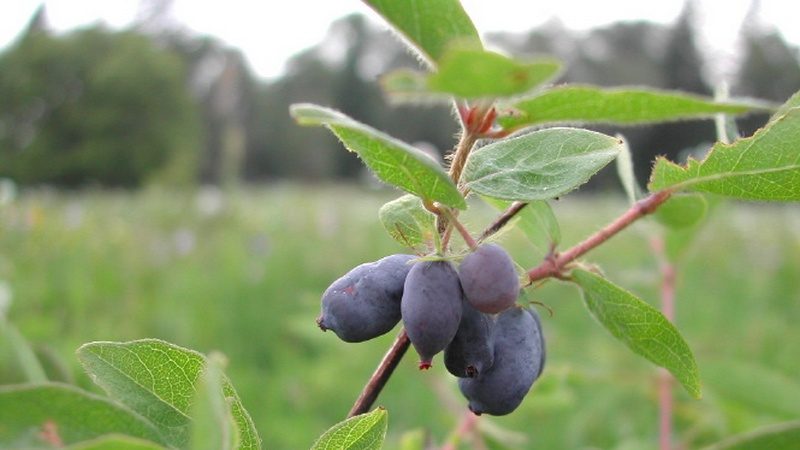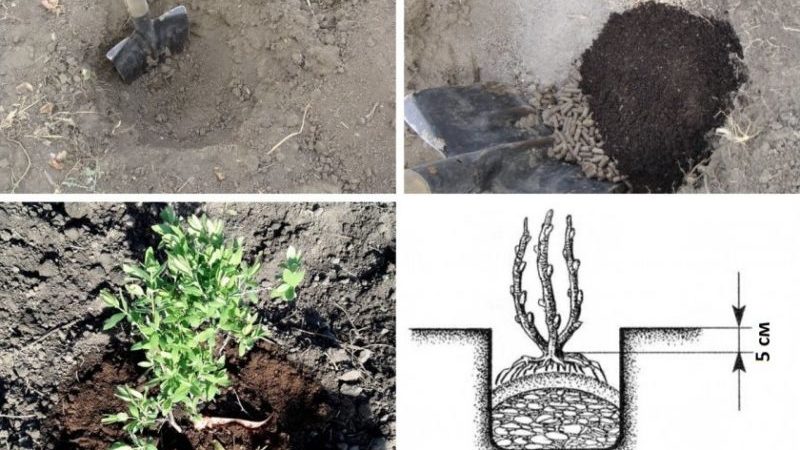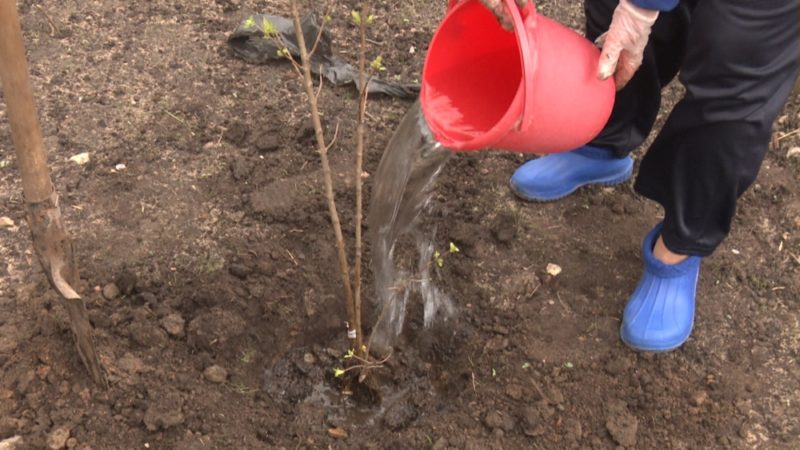Kamchatka honeysuckle - description and the best varieties
Honeysuckle is grown everywhere in Russia. Moreover, only a bush variety with blue and gray fruits is considered edible. Other types of honeysuckle are used for decorative purposes, as their bright and beautiful fruits are inedible and sometimes poisonous to humans.
Kamchatka honeysuckle belongs to the edible varieties of this culture. It bears fruit with oblong large berries, which contain many useful substances. At the same time, initially the fruits of the wild Kamchatka bush had a bitter tart taste, but the breeders bred varieties with higher taste characteristics.
And in the articles you will learn which varieties of Kamchatka honeysuckle are the most popular, and how to properly grow it on the site.
The content of the article
Description of wild Kamchatka honeysuckle

Kamchatka wild honeysuckle is shrub whose height varies within 1-2 m, but does not exceed 1.5 m... It grows in Kamchatka, Sakhalin, Siberia, the Kuril Islands, along the Okhotsk coast. Wild shrub is found in mixed forests and meadows. The plant is frost-resistant and hardy. It calmly endures even the coldest winters, is not afraid of windy and dry weather.
The shrub blooms in May. During this period, the shrub is covered with small yellow flowers. Fruiting lasts from June to July. The berries of Kamchatka honeysuckle are large, elongated, cylindrical or ellipsoidal. They are juicy, but tart and bitter in taste.
The fruits of Kamchatka honeysuckle are rich in vitamins B and C, the highest content of vitamin P. The berries also contain minerals, flavonoids, tannins.
The northern peoples use fresh berries, prepare jam from them. After freezing, the bitterness of honeysuckle becomes less pronounced, the fruits become sweeter and more pleasant to the taste.
It is interesting! Kamchatka honeysuckle berries are widely used in folk medicine. They have a diuretic, anti-inflammatory, immunomodulatory effect.
The best varieties of Kamchatka honeysuckle and their characteristics
The cultivated Kamchatka honeysuckle includes a whole group of varieties. On its basis, various improved plants were bred. They are distinguished by a more pleasant taste of berries, shape and size of fruits, productivity and some other characteristics.
Among the many varieties of Kamchatka honeysuckle, there are those that are most popular with gardeners. Each culture has its own pros and cons.
Kamchadalka
Honeysuckle Kamchadalka was bred by Siberian breeders. It is a frost-resistant early maturing plant.
Description of Kamchadalka honeysuckle:
- Bush. Medium-sized. The maximum height is 1.5 m. The crown is compact, narrow, inversely conical in shape. The branches are thick, knotty, strong, dark green with a purple tint.
- Leaves. Elongated, oval. The color is grayish green. The edges are slightly bent towards the center along the vein
- Fruit. Medium size. Oval shape. In length reach 2-2.5 cm, the average weight of the fruit is 1.5 g. Berries are leveled, with a smooth skin. Dark blue with a gray waxy bloom. Delicate pulp without bitterness has a sweet and sour taste and rich aroma.
- Ripening terms. Early maturing variety. Ripening occurs in the first half of June.
- Productivity. Average. Up to 2 kg of fruits are obtained from one bush.
- Features. Winter-hardy and drought-resistant variety.
- Immunity. There is immunity to diseases and pests.
Siberian
Sibiryachka was bred in 1972 in the Tomsk region.This honeysuckle variety has a sweet fruit with a rich aroma.
Description of Sibiryachka honeysuckle:
- Bush. Medium-sized. The maximum height is 1.6 m. The crown is spreading, oval in shape. Branches are thin, flexible, brown in color.
- Leaves. Elongated, oval, pointed. The color is bright green.
- Fruit. Medium in size, fusiform. The average weight of each berry is 1.5 g, and the length varies from 1.5 to 2.3 cm. The color is purple. The skin is thin, bumpy. The taste is sweet, with a slight sourness. The aroma is intense.
- Ripening terms. Early maturing variety. Ripening occurs in the first half of June.
- Productivity. High. Up to 4 kg of berries are harvested from adult honeysuckle.
- Features. Frost and drought tolerant variety.
- Immunity. There is immunity to diseases and pests.
Nymph
Honeysuckle nymph was bred in St. Petersburg. Its main feature is sweet fruits, practically without bitterness. But this is not its only positive characteristic:
- Bush. Medium-sized. The maximum height is 1.7 m. The crown is rounded. Sprawling, prone to thickening. Shoots are thin, flexible and strong, long and straight. They are green with a brown tint.
- Leaves. Dark green. Medium size. Elongated oval shape.
- Fruit. The fruits are large, elongated (up to 3 cm in length), curved. Each berry weighs on average 3 g. The shape is fusiform, slightly bumpy. The skin is thin, blue with a bluish tinge. The pulp is fibrous, juicy. The taste of berries is sweet and sour, slightly tart.
- Ripening terms. Mid-season. Ripening lasts from late June to early July.
- Productivity. Average. They collect 1.5-2 kg from the bush.
- Features. Differs in high frost resistance. Berries do not crumble from young plants, they fall from old bushes when ripe.
- Immunity. There is resistance to fungal infections.
In order for honeysuckle to give good yields, it is recommended to plant several bushes of other varieties on the site. The best pollinators for a nymph are: Blue spindle, Viola, Bluebird, Start.
Bakchar giant
The Bakchar giant is a tall, spreading shrub. This minus is fully paid off by tasty and large fruits.
Description of the variety:
- Bush. Tall, reaches a height of 2 m. The crown is rare, but spreading. It reaches 1.2 in width. The shape is oval.
- Leaves. Medium in size, rounded and elongated. The color is gray-green.
- Fruit. Large, elongated. The weight of each berry reaches 2.5 cm, and the length is 5 cm. The shape is oval-elongated, not aligned. The color is blue, there is a waxy coating.
- Productivity. High. About 3 kg per bush.
- Features. High frost resistance.
- Ripening terms. Mid-season. The berries begin to ripen at the end of June.
- Immunity. High resistance to viral and fungal diseases.
Blue spindle
Blue Spindle is a variety whose berry taste depends on weather conditions. The disadvantage is that ripe berries fall off the bush.
Blue Spindle Features:
- Bush. Stunted. The height does not exceed 1 m. The crown is sparse, compact, not spreading. The shoots are flexible, thin, green.
- Leaves. Elongated oval. The color is dark green.
- Fruit. Medium size. Fusiform. The length of the berry reaches 2.7 cm, and its weight is 1.5 g. The skin is dark blue, there is a gray waxy bloom. The taste is sweet with sourness. With a lack of moisture, the fruits acquire a bitter taste.
- Productivity. Average. Varies within 1.5-2 kg per bush.
- Features. High frost resistance and drought resistance. At the same time, a lack of moisture will negatively affect the taste of the fruit.
- Ripening terms. Early ripe. The fruits ripen from June 10 to 23.
- Immunity. High resistance to viral and fungal diseases.
Landing rules
In order for the honeysuckle harvest to cause pride, the plant does not hurt and develop correctly, it is important to choose a suitable site for it in the garden. A well-lit, wind-protected place is suitable.It is important that the groundwater does not run too close to the soil surface (no closer than 1.5 m).
Note! In place of the uprooted honeysuckle, a new bush is not planted for 4-5 years.
The soil should be loose and nutritious. Loam is considered the best option. In sandy soil, honeysuckle will also grow, but this will require more frequent feeding.
The selected area of the garden is prepared for planting Kamchatka honeysuckle for at least a month. The soil is dug deeply and cleaned of weeds. Measure acidity - if the indicators are not neutral (about 5-6 PH), add dry lime with high acidity and high peat with low.

When choosing seedlings, pay attention to the following parameters:
- Age and size. Saplings 2 years old take root best. The height of the planting material should vary within 30-40 cm. 2-3 branches are required.
- Root system. The root system must be well developed, have many processes. It is important to pay attention to the absence of rotting and dry roots. Good roots will be moist when cut.
- Branches. Should be flexible, not dry, if you scrape off the bark, you will find a green layer under it. The absence of damage is important. spots and other traces of the disease. Be sure to have live buds on every shoot.
Seedlings are sold with closed and open root systems. Planting material, the roots of which are in an earthen coma, take root better.
Note! Peeling on the bark and buds of honeysuckle is not a sign of seedling disease. This is a feature of culture, for which it is called by the people "shameless".
Honeysuckle is planted in early spring or after leaf fall. Wells are prepared 1-2 weeks before the procedure:
- Dig holes with a diameter and depth of 40 cm. The distance between the holes is made 1.5-2 m for low-growing varieties and 2-3 m for tall ones.
- The soil removed from the hole is mixed with 50 g of superphosphate, 30 g of potassium nitrate, 2-3 kg of manure, 1 kg of ash.
- The wells are watered with a light pink solution of potassium permanganate.
It is better to plant a seedling early in the morning or in the evening, when the sun is not active. This is followed by step-by-step instructions:
- A layer of drainage (crushed stone, expanded clay, broken ceramics) 5 cm thick is poured into the bottom of the hole. A mound of nutrient soil is formed in the center of the hole.
- The seedling is placed in the center of the hole. Its roots are evenly distributed over the mound.
- The hole is covered with the remains of soil with fertilizers, carefully tamping.
- Honeysuckle is watered with 2-3 buckets of water. The soil around it is covered with a layer of mulch.
Care

Kamchatka honeysuckle is an unpretentious and hardy plant. However, the basic care he needs. The basic rules are presented in the list:
- Watering... If it rains in summer, the honeysuckle is watered only 3 times per season. The first time it is done at the end of May, the second - in July, the last - after the harvest. In the dry season, the amount of watering is increased. Water is used settled, at room temperature. The soil is moistened when the sun is not active - early morning or evening.
- Loosening and weeding. After each watering and precipitation, the soil is loosened. This is done in order to destroy the earth crust, which promotes moisture stagnation and prevents normal root air exchange. In the process of loosening, weeds are removed, which are considered to be carriers infections and pests.
- Mulch... To reduce the amount of loosening, protect the roots from cold snaps, diseases and pests, slow down the growth of weeds, the soil around the honeysuckle is covered with mulch. They use rotted hay and straw, humus, peat.
- Formation... For the first 3 years, Kamchatka honeysuckle does not need pruning at all. Then cut out all the growth around the bush. Branches too close to the ground and shoots thickening the crown.
- Top dressing... Honeysuckle is fed from the third year after planting. The first top dressing is applied in early spring (before the buds open), 15 g of ammonium nitrate diluted in 10 liters of water are poured under the bush.The second time, fertilizers are applied after harvesting. They are prepared from 1 kg of rotted manure, 10 liters of water and 30 g of nitrophoska. The last fall dressing is prepared from 5 kg of rotted manure, 100 g of ash and 50 g of double superphosphate. Fertilizers are simply buried under the bush.
- Sanitary pruning... Sanitary pruning is carried out every autumn. I remove dry, broken, frostbitten branches and branches damaged by diseases and pests. Cutting places are treated with garden pitch.
For old plants that have decreased yields, rejuvenating pruning is carried out, all old branches are removed, leaving young shoots.
Conclusion
Kamchatka honeysuckle is a hardy and hardy shrub with edible fruits. It grows wild in regions with harsh climates. The plant produces large, but tart fruits.
Breeders have bred many varieties that are part of the Kamchatka honeysuckle group. They retained their resistance to negative environmental factors, but at the same time they have a more pleasant fruit taste and increased productivity.